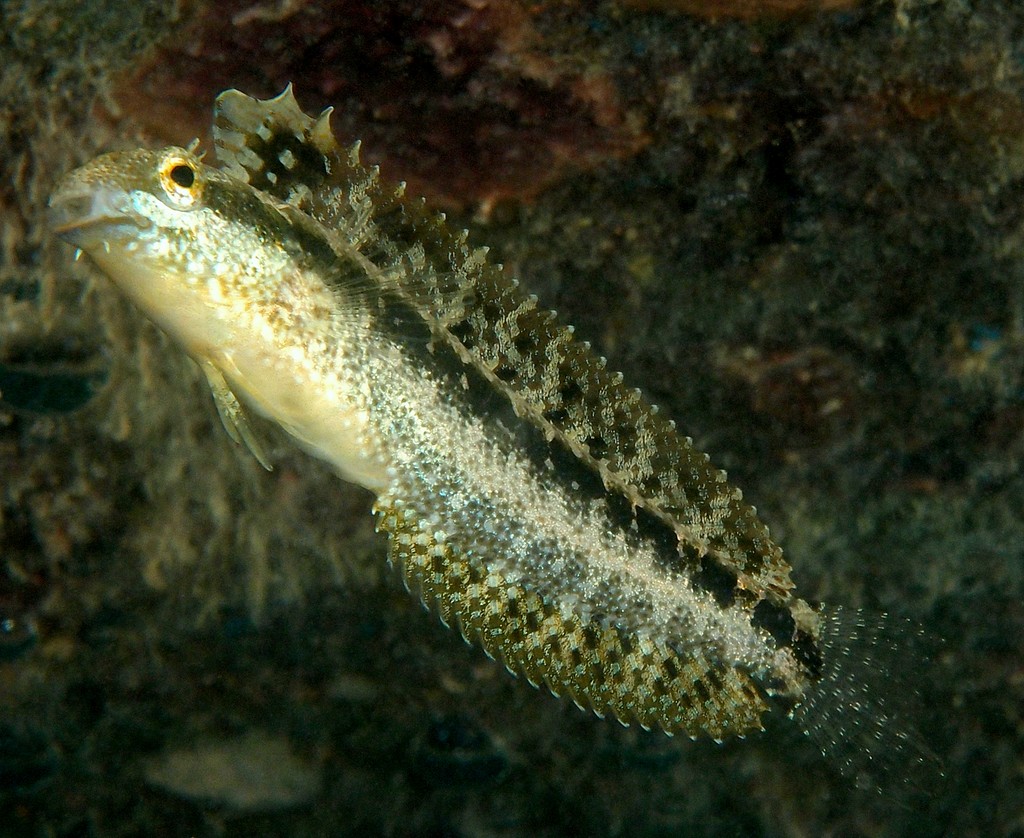PETROSCIRTES LUPUS - (DE VIS, 1885)
Actinopterygii (Gigaclass) > Actinopteri (Class) > Teleostei (Subclass) > Blenniiformes (Order) > Blennioidei (Suborder) > Blenniidae (Family) > Blenniinae (Subfamily) > Petroscirtes (Genus)
Blennie brune à dents de sabre, Brown sabertooth blenny, Brown sabre-tooth, Brown sabretooth blenny, Southern sabretooth blenny, Wolf fangbelly, 狼跳岩鳚,
Synonymes
Petroscirtes icelii (Ogilby, 1894)
Petroscirtes (Ostreoblennius) steadi (Whitley, 1930)
Salarius lupus (De Vis, 1885)
-------------------------
Description
Dorsal spines (total): 11; Dorsal soft rays (total): 19-20; Anal spines: 2; Anal soft rays: 18-20 (rarely: 18); Pectoral soft rays typically: 14; Segmented caudal rays: 1, unbranched. Jaw teeth incisiform, rigid, close-set, increasing with age; Large, curved canine tooth on each side at posterior of lower jaw, and smaller canine on each side at posterior of upper jaw (similar dentition shared within genera); Lower end of gill opening above level of pectoral fin base (also a shared character within genera); Small unbranched cirrus on each side of chin; With or without small supraorbital and nuchal cirri; Body depth at anal-fin origin: 4.5-7.0 SL; Males with elongated second dorsal spine; Unnotched dorsal fin; Caudal fin interradial membranes slightly incised, notably in males. Max. length: 13.0 cm TL. Depth range: 1 - 25 m, usually: 1 - 10 m.
Color
Ground color variable with habitat, gray, brown, or green, with 6 large, uneven dark blotches on upper side and numerous white dots and dashes and, ventrally, dark dots.
Etymology
Petroscirtes: from Ancient Greek, pétra = stone, rock + from Greek, skirteo = to jump. Referring to Rüppell’s claim that Petroscirte mitratus was seen jumping between rocks out of the water hunting for small amphipods; However, since Petroscirte mitratus is not amphibious, Rüppell may have confused it with Alticus saliens, observing both blennies at Jubal Island (Egypt, Red Sea) and thinking they were conspecific.
lupus: from Latin = wolf. Referring to large, recurved canine tooth on each dentary.
Original description: Salarius lupus De Vis, 1885 - Type locality: Moreton Bay, Queensland, Australia.
Distribution
Southwestern Pacific: Queensland, New South Wales, Lord Howe Island, Australia and New Caledonia.
Biology
Adults hide in seagrasses, seaweeds, or empty mollusk shells. Oviparous, distinct pairing. Mature females lay eggs on the inner surface of dead bivalve shells which are guarded by the male. Larvae are planktonic, often found in shallow, coastal waters.
Similar species
Petroscirtes variabilis (Cantor, 1849) - Reported from New Caledonia - Link to the species (here). Differ in having only 17 anal soft rays.
Last update: 22, August 2024
Blennie brune à dents de sabre, Brown sabertooth blenny, Brown sabre-tooth, Brown sabretooth blenny, Southern sabretooth blenny, Wolf fangbelly, 狼跳岩鳚,
Synonymes
Petroscirtes icelii (Ogilby, 1894)
Petroscirtes (Ostreoblennius) steadi (Whitley, 1930)
Salarius lupus (De Vis, 1885)
-------------------------
Description
Dorsal spines (total): 11; Dorsal soft rays (total): 19-20; Anal spines: 2; Anal soft rays: 18-20 (rarely: 18); Pectoral soft rays typically: 14; Segmented caudal rays: 1, unbranched. Jaw teeth incisiform, rigid, close-set, increasing with age; Large, curved canine tooth on each side at posterior of lower jaw, and smaller canine on each side at posterior of upper jaw (similar dentition shared within genera); Lower end of gill opening above level of pectoral fin base (also a shared character within genera); Small unbranched cirrus on each side of chin; With or without small supraorbital and nuchal cirri; Body depth at anal-fin origin: 4.5-7.0 SL; Males with elongated second dorsal spine; Unnotched dorsal fin; Caudal fin interradial membranes slightly incised, notably in males. Max. length: 13.0 cm TL. Depth range: 1 - 25 m, usually: 1 - 10 m.
Color
Ground color variable with habitat, gray, brown, or green, with 6 large, uneven dark blotches on upper side and numerous white dots and dashes and, ventrally, dark dots.
Etymology
Petroscirtes: from Ancient Greek, pétra = stone, rock + from Greek, skirteo = to jump. Referring to Rüppell’s claim that Petroscirte mitratus was seen jumping between rocks out of the water hunting for small amphipods; However, since Petroscirte mitratus is not amphibious, Rüppell may have confused it with Alticus saliens, observing both blennies at Jubal Island (Egypt, Red Sea) and thinking they were conspecific.
lupus: from Latin = wolf. Referring to large, recurved canine tooth on each dentary.
Original description: Salarius lupus De Vis, 1885 - Type locality: Moreton Bay, Queensland, Australia.
Distribution
Southwestern Pacific: Queensland, New South Wales, Lord Howe Island, Australia and New Caledonia.
Biology
Adults hide in seagrasses, seaweeds, or empty mollusk shells. Oviparous, distinct pairing. Mature females lay eggs on the inner surface of dead bivalve shells which are guarded by the male. Larvae are planktonic, often found in shallow, coastal waters.
Similar species
Petroscirtes variabilis (Cantor, 1849) - Reported from New Caledonia - Link to the species (here). Differ in having only 17 anal soft rays.
Last update: 22, August 2024
